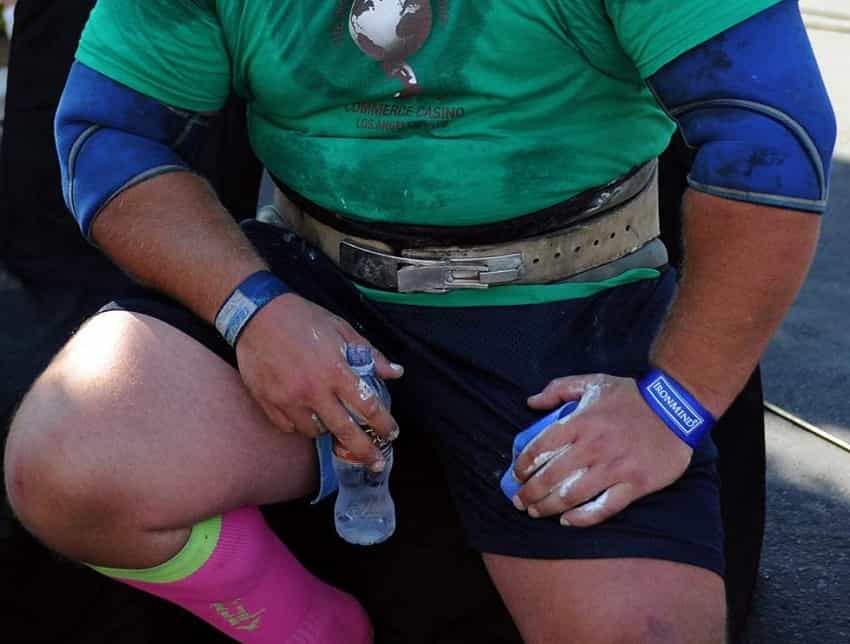
Lifting straps are a handy tool in your workout gear arsenal. They secure your grip on the bar, help with overload work, and keep your technique on point. Here’s a breakdown of the best weight lifting straps and why/when you should use them in your lifting efforts.
? Quick Picks:
- Best straps for dynamic lifting: IronMind Sew Easy Lifting Strap
- Best lifting straps for Strongman: IronMind Strong-Enough Lifting Straps
- Best straps for deadlifts: Serious Steel Fitness Figure 8 Straps
- Best padded weight lifting straps: Harbinger Padded Straps
- Best leather weight lifting straps: Deselen Leather Lifting Straps
- Best weightlifting straps/hooks: RIMSports Weight Lifting Hooks
Lifting straps are usually made of nylon, canvas, or leather, a couple of inches wide and around a foot to a foot and a half long.
They are most often used for heavy pull movements, like deads, but they can also be used for other moments your grip needs a little assist, like pull-ups or even kettlebell swings.
Alrighty, so with all that behind us, let’s take a closer look at the best lifting straps out there for you to haul in your gym bag.
Let’s go!
IronMind Sew Easy Lifting Strap
⭐ Top pick: Best strap for dynamic lifting
These flat-nylon straps from IronMind are ideal for lifters who perform dynamic workouts, moving quickly from one exercise to the next.
The biggest strength of the IronMind Easy-Sew’s are their versatility–with the shorter length it is easier to unravel the straps from the bar.
Durable, comfortable, and easy to get on and off the bar, the IronMind Easy Sew’s are my favorite go to for the lifter who needs to bounce between bars quickly and securely. They are reasonably priced, with a pair of them costing around $18 (check Amazon for current pricing and availability).
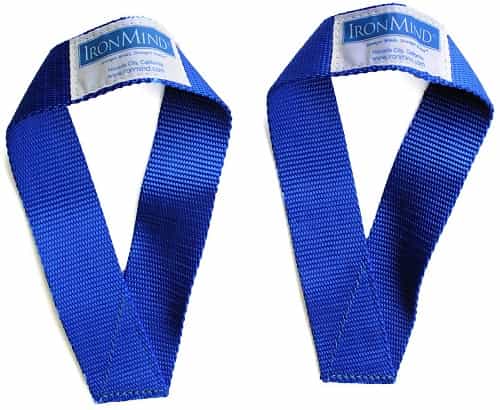
IronMind Strong-Enough Straps
⭐ Top pick: Best lifting straps for Strongman
On the other hand, if you’re maxing out your lifts and want a strap that is definitely not going to slow you down, the IronMind Strong-Enough Lifting Straps is what will do it.
Rated as one of the most durable lifting straps out there, and by far the most popular straps on the Strongman circuit (meaning you know they are built to take serious punishment), the IronMind Strong-Enough straps will handle anything you throw at them.
Like the IronMind Sew Easy’s, the Strong-Enough lifting straps retail for a little less than $20 (click here to see today’s pricing on Amazon).
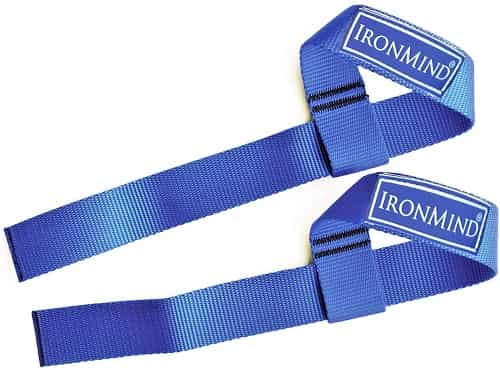
Serious Steel Fitness Figure 8 Straps
⭐ Top pick: Best straps for deadlifting
Another popular strap in the powerlifting and Strongman communities is the Serious Steel Fitness Figure 8 Straps.
Built to last with extra stitching for seam reinforcement, they come in three different sizes to accommodate lifters with varying wrist circumferences. Figure 8 straps are best suited for deadlifting as they fully lock your hands on the barbell.
Eddie Hall, 2017’s world’s strongest man, used these exact straps to break the world record in the deadlift when he pulled 500 kilograms off the ground.
The Figure 8 Straps are a little pricier, with their heavy-duty design ringing the cash register for $25 (check here for current pricing and availability on Amazon).
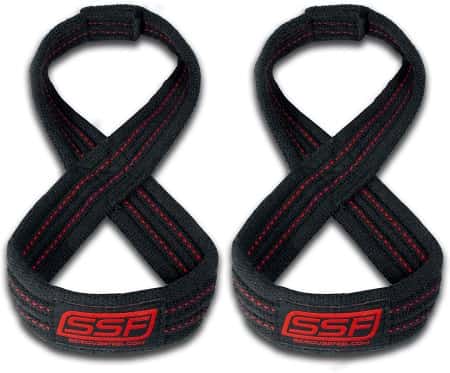
Harbinger Padded Cotton Lifting Straps With NeoTek Cushioned Wrist
⭐ Top pick: Best padded lifting straps
Harbinger is one of my favorite makers of “support gear,” whether it’s their weightlifting belts, tricep ropes, or lifting hooks. Their padded straps keep up the tradition of quality equipment.
The Harbinger Padded straps are great as they provide a comfortable and chafe-free lift strap. They have an extended length for stronger wrap and grip support and also have that extra padding for when you’re doing heavier lifts.
The 1 1/2 “ width also helps to improve the level of support you get while providing superior comfort.
They’re durable, comfortable, and perform well, so a good all-around lifting strap to hit the weight room with. Price-wise, you can’t really beat them, either, with Harbinger selling these straps for less than $10 (check here for current pricing at Amazon).
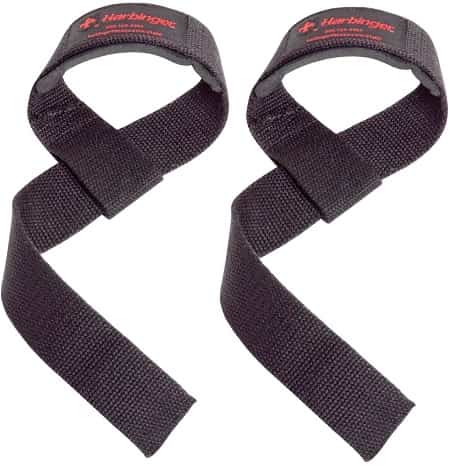
Deselen Optional Leather Lifting Straps
⭐ Top pick: best leather weight lifting straps
Made of soft cowhide leather, the Deselen lifting straps have a thick and soft cotton lining that makes these comfortable on your wrist and hands.
Ranked as a top Editor’s pick on Amazon, with an average rating of well over 4 out of 5 stars, these leather straps are more ideal for the lifter who doesn’t sweat like crazy (stick to nylon straps if that is the case).
Leather straps do take a couple of workouts to break in, so don’t be discouraged if the first time you try them the straps don’t wrap around the bar as tightly as you expect. Cost-wise, the heavy-duty leather option for lifting straps runs about the same as nylon straps, with this pair costing about $20 (check Amazon for current pricing).
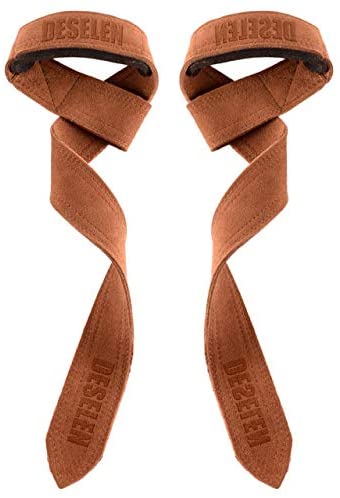
RIMSports Weight Lifting Hooks Heavy Duty Lifting Wrist Straps
⭐ Top pick: Best weightlifting straps/hooks
While not technically considered a strap, weight lifting hooks are becoming more popular among some lifters. If you aren’t one for having to wrap a strap around the bar, you might just find that these hooks fit the bill perfectly.
They do give a bit of a different feel when the bar is in your hands, but the good news is that using them literally takes mere seconds. Just wrap the strap around your wrist and you’re set. There’s no more setting up for your lifts – you’re ready to go at a moment’s notice.
Do keep in mind though that with any lifting strap hook, you will lose some security due to the fact the bar isn’t wrapped tightly in the wrap but rather, just sitting in the hook.
RIMSports’ lifting hooks cost $20 and are available at Amazon.
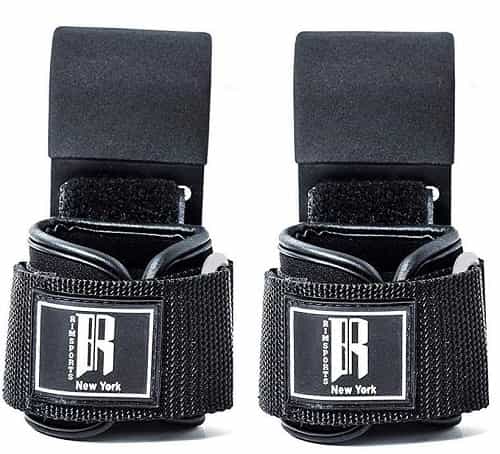
Lifting Straps – FAQs
Is using lifting straps considered cheating?
Lifting straps can instantly improve your ability to pull in the gym, which can lead some to view it cheating or inflating your true strength capacity.
But straps, when used properly and not all the time as a crutch, are a way to maximize your strength and target larger muscle groups.
Lifting straps help bypass the weak link in the chain so that you can lift more while also protecting your wrists and elbows when you want to go really heavy.
Of course, lifting straps shouldn’t be used in perpetuity as a substitute for strengthening the wrist or forearms. Make sure to build your strengths while addressing the weak parts of your lifts.
What are the best lifting straps for deadlifts?
For deadlifts, figure 8 straps are the best kind of lifting strap you can use due to their increased security on the barbell.
Figure 8 straps “lock” your hands onto the bar, which makes them less ideal for exercises and movements where you want to be able to drop the bar quickly.
Overhead lifts, where you may be dropping the barbell from up top, are an example of a type of lift where you want to be able to separate yourself from the bar quickly and makes them less suited for figure 8 straps.
Additionally, I would not recommend figure 8 straps for exercises such as pull ups, as you want to be able to detach yourself from the bar easily in the case of failure.
Should you use lifting straps?
Depends!
Here is why (and when) I use them:
- Lifting straps are an alternative to gloves. Using straps is very similar to using weightlifting gloves. They provide a secure grip on the bar, whether it’s doing pull-ups (whether on a doorway pull-up bar or on a stand-alone pull-up bar), deadlifts, or even dumbbell bench press.
- Straps make the bar thicker. Wrapping the strap around the bar makes it thicker, which is handy for guys like me who have long, skinny-ass fingers that can nearly wrap themselves twice around the bar. (You could also use thick bar grips for this purpose.)
- Ideal for overload work. When your grip is getting fatigued, lifting straps come to the rescue. Often my wrists are the first to get fatigued when it comes to heavy deads and pulls. That said, you shouldn’t use them all the time, otherwise, that weak wrist will get weaker.
- Lifting straps make for better pulls. Instead of worrying about your grip, lifting straps allow you to focus exclusively on the pulling portion of the lift. This usually means you are able to go a little heavier than usual.
- Not for beginners. If you are new to lifting, straps won’t be necessary for a few months. Give yourself a chance to build a solid foundation of strength, particularly in your grip, before reaching beyond your PR’s with straps.
How often should you use lifting straps?
Lifting straps are a simple and wildly effective tool for helping you lift more weight in the gym. As a matter of fact, they can be so darn helpful that we start using them as a crutch.
Although the short-term gains of using lifting straps continuously will be awesome (lifting more weight, more regularly = every lifter’s idea of a good time), with your shoulders, arms and back getting plenty of added benefit, this comes at a cost as your wrist, forearm, and grip will become less stable.
If you plan on lifting with straps all day every day, make sure to balance it out by targeting your grip and forearm.
- Farmer’s carries. One of my favorite all-time exercises that can be done with a kettlebell or dumbbell (or even a barbell).
- Using a hand grip strengthener.
- Dead hangs from pull up bar
And so on.
There are lots of ways to power up your grip, so if you plan on using lifting straps frequently, add some grip strengthening to your training regimen to balance it out.
What’s better, using chalk or lifting straps?
Another tool that lifters of all stripes use to secure grip on the barbell is chalk.
This delightful powder rapidly absorbs sweat and moisture so that the palm and fingers don’t slip and slide around on the bar.
Chalk is a great tool as it secures the grip without sacrificing the opportunity of grip improvement. In other words, chalk gives you a chance to improve your grip strength along with targeting the larger muscle groups.
Chalk, however, is messy, causes grip fatigue (your grip will tire faster compared to using lifting straps), and not many gyms allow lifters to use it.
Lifting straps, on the other hand, allow you to perform more sets and reps as the grip isn’t compromised, making it ideal for days when you need to get a lot of volume in over the bar.
Should you use wrist straps for pull-ups?
Pull ups are one of the best exercises on the planet for developing a strong back. There are a ton of different ways to train for this exercise, from doing dead hangs to alternating your grip on the pull-up bar.
When it comes to using lifting straps for pull-ups, it depends on the context of how you use them.
For people just getting into the swing of doing pull-ups, straps can help reduce the likelihood of injury and give you the confidence (and strength) to progress towards doing pull-ups without straps.
Weighted pull-ups are another scenario where I prefer using straps, as it gives me that extra sense of “security” when stepping up to the pull-up bar and allows me to more fully engage the back.
Again, with lifting straps and pull-ups, it comes to finding the right balance between developing back strength and building the grip and forearm strength to do pull-ups.
While lifting straps can be a stepping stone, if you want to master the pull-up, there’s no getting around the fact that you will have to develop the requisite forearm strength to execute the movement properly.
More Gear Guides:
Best Weightlifting Shoes: Our buyer’s guide on the best platform shoes for dominating your workouts.
Best Weightlifting Books: Looking to up your knowledge on lifting? Check out my breakdown of the best books for those serious about getting their lift on.
Best Weightlifting Gloves: For those who are looking for hand protection and improved grip, but don’t want to use straps, here are the best gloves for lifting with confidence.
The Best Socks for Deadlifting Big. Protect your shins, reduce lifting deficits, and get to deadlifting like a boss with a breakdown of the best socks for PR-busting deadlifts.
5 Best Mouth Guards for Weightlifting. The right mouthguard will help you lift more, protect your teeth, and help you breathe like a champ. Here’s a breakdown of the best mouthguards for lifting weights.
